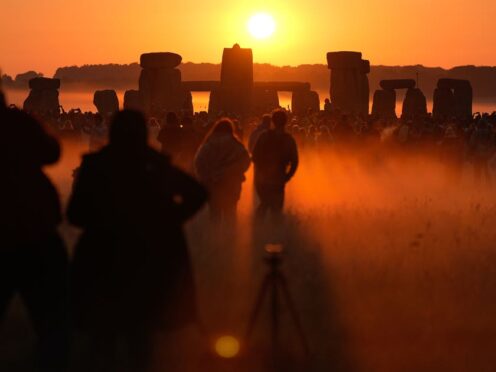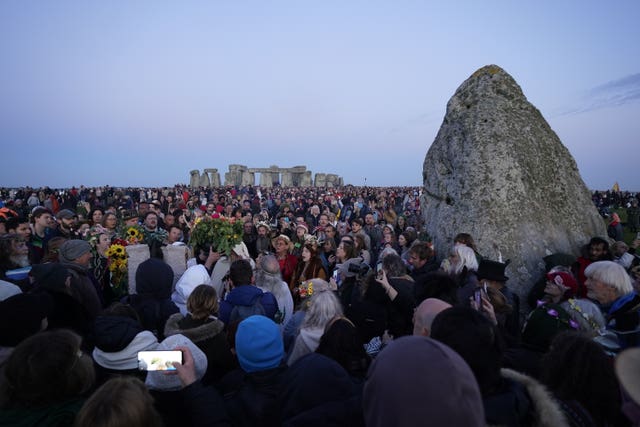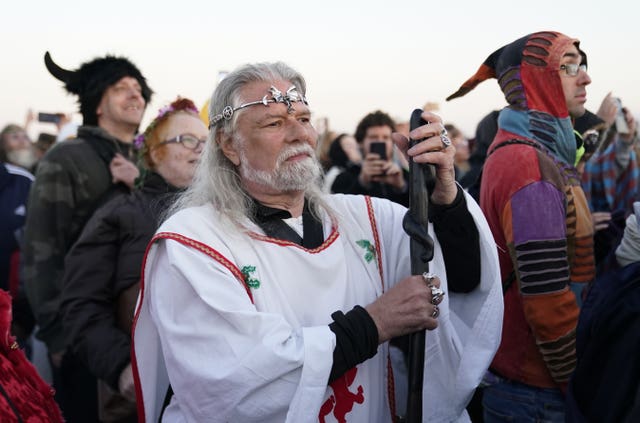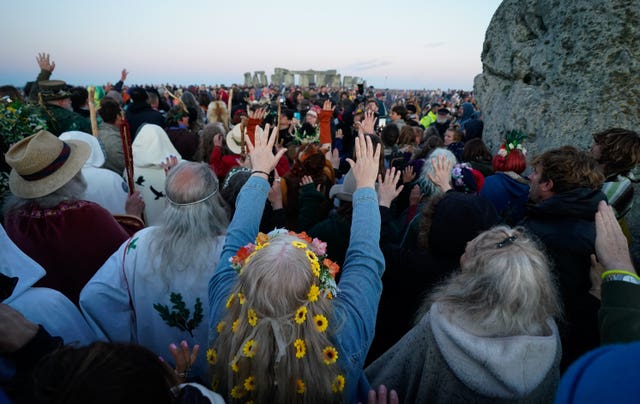
Around 15,000 people greeted the sun with cheers, drumming and chanting as it rose over Stonehenge for the summer solstice, just days after the ancient monument was sprayed with orange paint.
Those who observed the spectacle at the neolithic structure in Wiltshire encountered a chilly morning accompanied by misty fields as the Sun glinted over the horizon at 4.52am on Friday.
The solstice events at Stonehenge are some of the rare occasions people are allowed to be close to the stones, which sit at the heart of a World Heritage site and date back thousands of years.
On Wednesday, Just Stop Oil protesters ran past barriers and sprayed orange powder paint at a number of the stones.
Wiltshire Police later arrested and bailed a man in his 70s and woman in her 20s on suspicion of criminal damage, damaging an ancient monument, and deterring a person from engaging in lawful activity.
English Heritage said experts had removed the powder quickly, as there was a risk it would harm rare lichens growing on the stones and could leave difficult-to-remove streaks if it came into contact with water.
The charity confirmed there appeared to be no “visible damage” from the paint but the act of removing it could erode the fragile stone and damage the lichens.

Many of the attendees who gathered to celebrate the solstice expressed their frustration and disapproval at the protest.
King Arthur Pendragon, a senior druid and pagan priest, said people from “every single continent” were present at Stonehenge for the summer solstice.
He added: “It was a wonderful atmosphere, a very eclectic mix. Some people were just ticking it off the bucket list, others returning for a second, third, fourth, fifth time. I’ve been coming here since the 1980s.
“I think the vandals shot themselves in the foot because the sort of people you see around us would have been their natural allies and of course they’ve alienated us all.
“I am well known as a protester, well known as an environmentalist, and if they’ve upset me, they’re doing something wrong.
“There are far better ways of drawing attention to yourself and your cause. They’re called Just Stop Oil. There’s no oil here. Why aren’t they hitting oil companies? How did they get here without the use of oil?
“Irrespective of what they tried to do to Stonehenge, we’ve had a good crowd, a good gathering, and we had a happy solstice.”

Sally Ann Spence, an archaeology enthusiast who dressed as a shaman dug up from the Mesolithic period which pre-dates Stonehenge, described the solstice celebrations as “incredibly important”.
When asked about the protest, she said: “I understand their cause, I respect their cause. I just wish they hadn’t done that on Stonehenge.
“I think to put anything on the stones is slightly misguided, there are very rare lichens on the stones, it’s a World Heritage site.”
She continued: “Being here for the solstice and representing a shaman – admittedly, from a different period of time – is a brilliant experience.
“It’s exciting. It’s very busy at the moment and I’m loving it because I’m using it as a chance to talk to people about actual archaeology.”

Laura Debane, who was attending the solstice at Stonehenge for the fifth time, said Just Stop Oil spraying the monument was “awful”.
She added: “If you want to make a protest go somewhere it’s going to mean something, not in a historical place like this because there’s no oil here, it’s sacred ground.”
Ms Debane said she was glad the protest did not ruin the event and people were still able to come out and enjoy it.
English Heritage said around 15,000 people attended Stonehenge, with more than 200,000 people tuning in to an online livestream hosted by the charity.
Becky Eade, director of Stonehenge for English Heritage, said: “Coming together at Stonehenge for the summer solstice is a tradition that brings people from near and far, to see in the start of the longest day and celebrate the changing seasons.
“This morning was a joyous and peaceful occasion with the most beautiful sunrise. It is fantastic to see Stonehenge continuing to enchant and connect people.”
Wiltshire Police described the event as “peaceful” and said there was just one arrest – a 49-year-old man from Exeter detained on suspicion of assaulting a security officer. He was later released without charge.
Assistant chief constable Dave Minty said: “This year’s summer solstice was a safe and successful occasion and I’d like to say a huge thank you to everyone who attended, our communities and the visitors to the site.
“Thank you also to our partners, stakeholders and of course English Heritage, for working with us because collectively we have ensured that everyone could enjoy the event peacefully.
“And finally, thank you to our officers, staff and volunteers who worked through the night at such an incredible event.”
Stonehenge is a monument built on the alignment of the midsummer sunrise and the midwinter sunset.
On the summer solstice, the Sun rises behind the Heel Stone -the ancient entrance to the Stone Circle – and rays of sunlight are channelled into the centre of the monument.
It is believed solstices have been celebrated at Stonehenge for thousands of years.
Summer solstice takes place as one of the Earth’s poles has its maximum tilt toward the Sun and the Sun reaches its highest position in the sky, ensuring the longest period of daylight for the year.

Enjoy the convenience of having The Sunday Post delivered as a digital ePaper straight to your smartphone, tablet or computer.
Subscribe for only £5.49 a month and enjoy all the benefits of the printed paper as a digital replica.
Subscribe